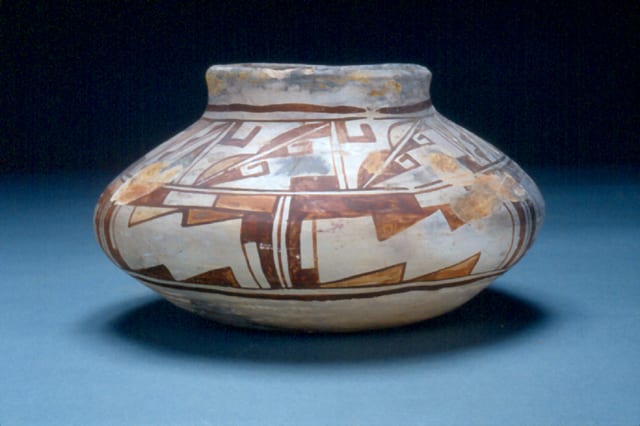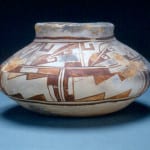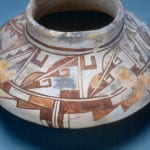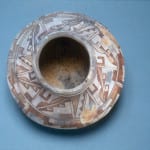Hopi, Polacca Ware “D” bowl, 1890-1910 According to Wade and McChesney (1980:77), “Style D Polacca Polychrome or Sikyatki Revival Ware (A.D. 1890-1900) appears to have been a commercial ceramic tradition begun in the closing years of the nineteenth century and characterized by initial experimentation with prehistoric and early historic forms and designs. Polacca Polychrome Style D is transitional between Style C and twentieth century Sikyatki Revival Polychrome. These ceramics are distinguished from earlier Polacca styles by the incorporation of prehistoric designs and vessel shapes and their production solely for sale to Thomas Keam.” As Wade & McChesney (1981:455) note, “Except for changes in vessel shape and decorative motifs (both of which are revivals of earlier traditions), Style D Polacca Polychrome has the same paste, pigment, and characteristic crazed slip of Style C vessels.” This pot well illustrates these changes: it has a classic Sikyatki shape and balanced angular designs (which are a sharp break from the earlier Polacca Polychrome tradition), but the white slip is characteristic of the Polacca Polychrome style. Note traces of four dots (the four cardinal points?) on the rim, typical of this style of Polacca ware. The typical Sikyatki-revival design of this piece is in sharp contrast to the funkier fun doodles that characterize 1994-16, another Polacca “D” pot in my collection. Pot 1992-05 is clearly part of an evolving tradition; pot 1994-16 has an unbalanced idiosyncratic design that reflects more individual whim than clear tradition of design.
For other Polacca pots in the collection, see “Polacca Ware” in the Category listing.




